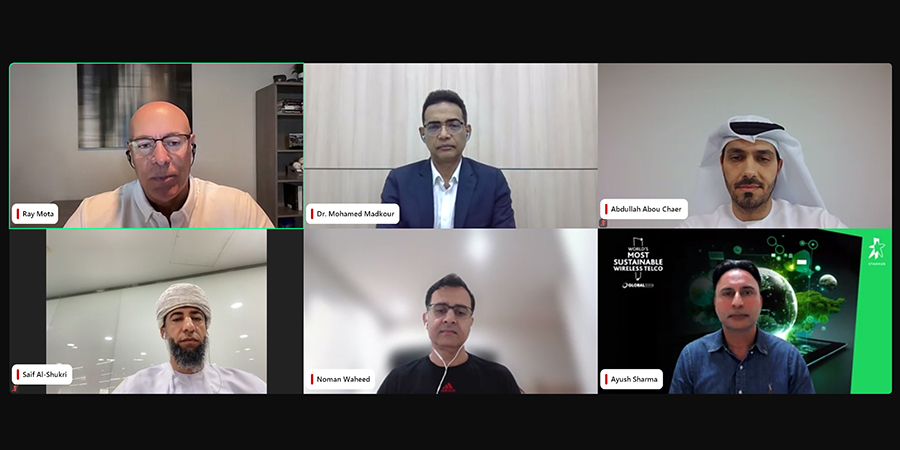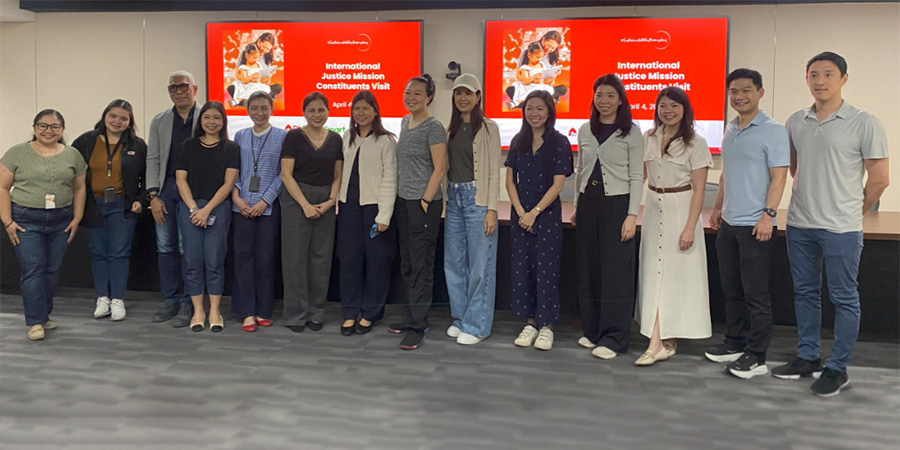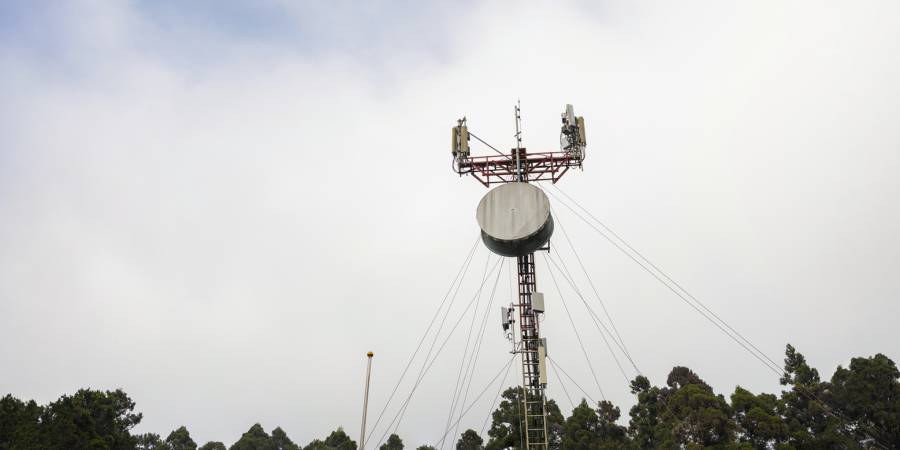On August 22, 2024, Telecom Review organized a virtual panel entitled “Technology Chiefs Delve into 5G-Advanced,” where a panel of industry experts shed light on the current trends in 5G-A adoption and digital transformation outcomes at length.
Issam Eid, Chief Operating Officer, Telecom Review Group, delivered the welcome note along with a brief outline of the 5G-A talking points set to be uncovered throughout the discourse. The discussion was moderated by Dr. Ray Mota,CEO, ACG Research.
The esteemed panelists included:
- Saif Al-Shukri, Department Head – Radio Network Planning (Mobile & Fixed) at Ooredoo Oman
- Noman Waheed, CTO, Middle East, Mobile Networks, Nokia
- Ayush Sharma, CTO, StarHub
- Mohamed Madkour, Vice President, ICT Strategy & Marketing, Huawei Middle East and Central Asia
- Abdullah Abou Chaer, Director Data Management and Cognitive Services, du
After a quick round of introduction of the prestigious speakers, Dr. Ray Mota,CEO, ACG Research, set the stage for the discussion and expounded upon the ‘Gs’ in the telecom industry—2G, related to mobile voice; 3G, related to mobile data; 4G, related to mobile internet; 5G, related to internet of things and 5.5G or 5G-Advanced or 6G, related to mobile intelligence.
He explained that the transition to 5G primarily encompasses achieving ultra-low latency, which is crucial for real-time applications that require instant responses. He also highlighted other key aspects of 5G, such as the improved user experience for real-time streaming, cloud computing, gaming, and other rich applications.
Additionally, 5G can support over a million connected devices, a significant increase from the 100,000 devices supported by 4G. He mentioned the concept of 5G network slicing, which allows operators to create multiple virtual networks within a single physical 5G network, optimizing it for specific use cases. Finally, he emphasized the benefits of spectrum efficiency and energy-efficient green networks with 5G.
Analyzing the enormous potential of 5G, the discussion sought to explore the transition to 5G-Advanced through 3 distinct aspects: infrastructure, implementation and monetization.
Enhancing Infrastructure for 5G-Advanced Deployment
When asked about the developments in the 5G-Advanced adoption across geographies, Dr. Mohamed Madkour, Vice President, ICT Strategy & Marketing, Huawei Middle East and Central Asia, stated that 5G-Advanced is positioned to bridge this gap, enhancing the capabilities of the existing 5G infrastructure.
He explained that 5G has seen significant adoption over the past five years globally, with 1.8 billion users and over 3,000+ terminals covering 40% of the world’s population. “Notably, China leads the charge with half of these users and millions of base stations in operation. Despite only 20% of global connectivity being through 5G, this technology accounts for 30% of traffic and 40% of revenue, showcasing its growing importance in the telecom ecosystem.”
Dr. Madkour pointed out that out of six million 5G base stations globally, China accounts for four million of them. He also mentioned that there are currently 0.5 million global RedCap base stations, a key component of 5G-Advanced technology.
In terms of regional advancements, Dr. Madkour highlighted that the GCC countries are on track to lead the way in achieving 10 Gbps speeds, which represents a significant leap forward in network performance. Meanwhile, Latin America and the European Union are making strides in pioneering 3CC carrier aggregation, mmWave technology, and innovations associated with Horizon and Release 18.
Dr. Madkour also emphasized the critical importance of mobile phones supporting 3CC carrier aggregation, which allows devices to combine multiple frequency bands for faster and more reliable connections. Mota strongly agreed with this perspective, recognizing it as essential for the future of 5G-A adoption and commercialization.
Also Read: 35 Cities and Regions Unite to Launch a New Era of 5G-A Connectivity
The Implementation of 5G-Advanced
When asked about the key technical challenges in deploying 5G-A three carrier component (3CC) aggregation networks, Saif Al-Shukri, Department Head – Radio Network Planning (Mobile & Fixed) at Ooredoo Oman, stated that its implementation requires the availability of spectrum, which often necessitates rearranging the current spectrum to free up space for 5G. Securing adequate spectrum is crucial, as it determines the network’s ability to support multiple carriers and deliver enhanced performance.
Another major challenge is the need for robust backhauling solutions to handle the increased data throughput that comes with 3CC aggregation. Al-Shukri emphasized the importance of integrating mmWave technology to boost network capacity and throughput. To further enhance connectivity, he suggested embracing an e-link option as a complement to fiber, ensuring that both e-link and micro-link technologies work seamlessly together to provide reliable transmission.
Device compatibility also poses a significant hurdle, as 3CC aggregation demands support from a wide range of devices. Al-Shukri pointed out that market cost and distribution considerations must be factored in to ensure that devices are both affordable and widely available. He also noted that in regions like Oman, there has been progress in integrating Sub-6 GHz and mmWave technologies to manage site load effectively, a critical aspect of maintaining network performance under heavy traffic conditions.
Finally, Al-Shukri highlighted traffic balancing as another key component of the deployment process. Proper traffic management is essential to ensure that the network can handle the increased data demands without compromising on speed or reliability.
Commenting on the implementation of 5G-Advanced, Noman Waheed, CTO, Middle East, Mobile Networks, Nokia, noted that the availability of spectrum has been one of the key factors contributing to the highest speeds globally. The country has already started rolling out 3CC indoor networks with speeds up to 4.5 Gbps.
He noted that the GCC is “blessed with spectrum,” highlighting the availability of 300 MHz in the Sub-6 GHz range. This ample spectrum has been a key factor in the region’s ability to advance rapidly in 5G technologies. He pointed out that Qualcomm’s achievement of 4.5 Gbps speeds using three-component carrier (3CC) aggregation in 2023 is a testament to the potential of 5G-Advanced in the region.
Waheed also mentioned that the UAE has been recognized for its leadership in 5G, with Ookla rating it as the number one country globally for 5G download speeds. This recognition underscores the efficiency of the equipment and infrastructure in place, but Waheed cautioned that maintaining this efficiency requires careful management of site volume. He stressed that the site volume needs to remain consistent to ensure that network performance does not degrade as more users and devices come online.
Furthermore, Waheed highlighted that the 3 GHz spectrum is available in the GCC, which is crucial for supporting 5G-Advanced networks. The availability of this spectrum for commercial users is another key advantage that positions the region at the forefront of 5G adoption. Finally, he noted that the UAE is also pioneering the use of mmWave technology, with ongoing site learning and optimization efforts.
When asked about the challenges du faced in achieving the targeted 5 Gbit/s downlink rates, Abdullah Abou Chaer, Director Data Management and Cognitive Services, du, explained that one of the main obstacles was site loading. Initially, the site loading for 2G, 3G, 4G, and early 5G deployments was adequate. However, with the introduction of newer technologies, especially in densely populated areas with high traffic, the demand for site loading increased significantly.
Chaer also mentioned that their goal is to achieve 25 Gbps for backhauling, which presents additional challenges, particularly with microwave sites that struggle to meet these higher demands. To address this, most of du’s sites are connected by fiber and are currently being upgraded from 10 Gbps to handle the increased speeds required for these expansions.
Also Read: 5.5G Pivotal in Exploring Industrial Dividends
How Operators Can Prepare for 5G-Advanced Integration
Discussing how operators can prepare for 5G-Advanced integration, Madkour emphasized that operators preparing for 5G-Advanced integration should focus on several key areas: implementing autonomous networks, establishing robust IT systems for B2B enterprises, and developing edge computing networks. He also highlighted the importance of building data centers, addressing latency issues, constructing privacy architecture, and recognizing the critical role of transport infrastructure. Additionally, considering the interests of all stakeholders is essential for successful integration.
Waheed expanded on Madkour’s points by describing 5G-Advanced as “an evolution, not a revolution,” and elaborated on Nokia’s four ‘E’ approach to this progression. He outlined the first ‘E’, Experience, focusing on enhancing customer experience beyond just broadband, with improvements in XR mobility, reduced latency, doubling throughput, and increasing uplink capacity. The second ‘E’, Extension, involves exploring new segments and use cases, including device-to-device communication, highlighted by Nokia’s partnership with AST SpaceMobile for device-to-device satellite connectivity. The third ‘E’, Expansion, addresses the need for reliable synchronization beyond GPS, which is critical for industries like banking and for achieving precise 5cm positioning in environments such as AGVs, warehouses, and malls. Finally, Excellence emphasizes the role of AI and machine learning in boosting operational and energy efficiency within the 5G-Advanced framework.
Al-Shukri added that network and AI integration is important, as is bandwidth for transmission, and vendor support. He noted that operators need to “break down their thinking,” automate solutions and networks, introduce multi-carrier handling, collaborate with other operators and content creators, enlist government support and focus on customer calibration.
Telecom Review Exclusive Interview: Empowering the Future: How 5G-Advanced (5G-A) Redefines Connectivity for Businesses and Society in the Middle East
3GPP From a 5G-Advanced Perspective
Discussing the importance of adhering to third-generation partnership project (3GPP) specifications before marketing 5G-Advanced (5G-A) solutions to telecom operators and vendors, Chaer emphasized interoperability as the first point of standardization. He noted that interoperability among equipment vendors such as Huawei, Nokia, and other industry players, enables operators to avoid being locked into one equipment only.
Chaer highlighted that tracing or tapping points in 5G-Advanced and 5G standalone (SA) networks can present limitations in terms of monitoring and security. He pointed out that these challenges are often addressed by equipment vendors through their solutions, which are integrated into their ecosystem to provide enhanced monitoring capabilities and ensure robust network security.
Additionally, the director highlighted the issue of handset compatibility, noting that varying interpretations of standards among manufacturers create challenges. He emphasized the need for consistent standardization to address these issues and ensure uniformity across devices.
Recalling the early days of 5G, he mentioned that some operators hesitated to invest due to the immaturity of the standards. He stressed that standardization is essential for ensuring the longevity of investments, allowing for upgrades to future releases that can accommodate multiple use cases and integrations.
Waheed acknowledged the finalization of Release 18 by 3GPP, defining it through experience, extension, expansion, and operational excellence from a 5G-A perspective.
Nokia has had an active role in 3GPP standardization, focusing on extended reality (XR) functionality, uplink improvements for performance, enhancements, and new use cases such as unmanned aerial vehicles (UAVs) and the Future Railway Mobile Communication System (FRMCS).
With the shutdown of 2G and 3G network technologies by most operators, additional spectrum is being allocated for 5G deployment. Waheed noted that utilizing low-band frequencies will enable Sub-6 GHz, enabling the extension of uplink coverage. He also promulgated Nokia’s partnerships with Qualcomm, MediaTek, Samsung, and Apple to ensure seamless deployment, illustrating the company’s successful demonstration of reduced capability (RedCap) use cases to operators as an example.
In this regard, Waheed rereferred to the old African proverb, “If you want to go fast, go alone. If you want to go far, go together.”
Also Read: Huawei Highlights Open Gateway’s Crucial Role in Shaping 5G-A Networks at MWC Shanghai
An Operator’s Perspective on Commercialization, AI and ML in 5G-A
Highlighting roll-out plans related to AI, ML, and 5G-A, Ayush Sharma, CTO, StarHub, discussed the company’s recent accomplishment in facilitating the first data call over open radio access network (RAN) and standalone networks.
As one of the early deployers of 5G SA, this milestone represents one of the incremental innovations that StarHub is developing. Sharing StarHub’s journey in integrating AI and ML within the 5G network, Sharma mentioned that they are close to launching a hybrid integrated cloud with 5G access, alongside 10 Gbps home broadband and over-the-top (OTT) services, delivering low latency to the region.
Addressing the use of large language models (LLMS) for power efficiency, Sharma pointed out the fundamental challenge of utilizing AI and ML in isolated sectors, emphasizing the need for observability, automation, and centralization for network-wide applications.
Sharma emphasized the significance of machine learning operations (ML Ops) in enhancing the user experience by focusing on the intent expressed through devices. He explained that the quality and relevance of data are crucial, as they directly influence how users perceive their interactions with the system. Sharma stressed that the ultimate goal of ML Ops is to develop meaningful and clean data that can be effectively utilized for machine learning applications. This involves ensuring that the data is not only accurate and relevant but also handled in a way that aligns with user expectations and privacy concerns, thereby enhancing the overall customer experience.
Furthermore, he discussed StarHub’s implementation of network slicing, which has facilitated exposure to the CAMARA Application Programming Interfaces (API) gateway and Independent Software Vendors (ISV) ecosystem. He accentuated observability and automation as StarHub’s network demark points, particularly at key connectivity endpoints such as home broadband and mobile services.
Also Read: Unleashing the Future: Endless Possibilities With 5G Advanced
Monetization of 5G-Advanced
Dr. Madkour discussed the monetization opportunities presented by 5G-Advanced, noting that innovations in services and the ability of operators to deliver a multi-dimensional experience across various telecom customer segments are significantly enhanced with this technology.
He emphasized that the improved uplink speeds of 5G-Advanced could present new revenue streams by allowing operators to bundle high-speed throughput with different user categories, thereby creating fresh opportunities for generating income and offering tailored services.
He cited examples of telecom operators, such as China Mobile in China, doubling ARPUs by providing innovative B2B services by incorporating AI and cloud computing capabilities into the different segments of the user experience. China Mobile achieved 5G-Advanced monetization goals through a three-tier approach, offering services at 3 Gbit/s, 10 Mbit/s, and featuring a mobile icon for 5G-Advanced. It also introduced specialized packages for live streamers, traders, and gamers, tailored to their specific requirements. These packages include various options based on data packets, upload speeds, and low latency to meet the unique needs of these user groups.
In terms of 5G-Advanced monetization, Madkour highlighted that IPE intelligence optimization and closed-loop customer experience are crucial for successful implementation and profitability. He cited Thailand’s “hotspot on the go” initiative as an example of leveraging 5G-Advanced to enhance service offerings. Additionally, in China, various monetization strategies have been implemented, including new calling features, cloud calling, IT servers for storage and cloud services, and AI tools for influencers, all aimed at maximizing the benefits and revenue potential of 5G-Advanced technology.
Adding to the conversation, Waheed said, for CSPs, from a 5G-A perspective, non-terrestrial network, direct-to-device, and enhanced RedCap technologies can present a plethora of new use cases in sectors such as smart cities, oil and gas, and public safety by providing higher data rates compared to LTE Cat 4 devices. He noted that operators can tap into new revenue streams through models such as Timing as a Service (TaaS) and Synchronization as a Service (SyncaaS) as part of Release 18.
Read More: ZTE at MWC 2024: Panoramic Planning and Innovations for the 5G-A Era
Audience Contribution
Addressing a question from the audience on how developing countries with limited resources can move to 5G ecosystems, Waheed stressed the importance of understanding the percentage of devices that are capable of supporting 5G as it is the indicator of the level of preparedness for the services in the network.
At the end of the discussion, four poll questions were posed to the audience, revealing the following results: For the timeframe to fully-fledged 5G-Advanced commercial networks, 28% expect it to occur within 2 to 3 years, 61% within 5 years, and 11% within 10 years. Regarding the ideal segment for new 5G-Advanced services, 35% chose consumers, 12% homes, and 53% enterprises. The industry most likely to be transformed by 5G-Advanced was seen as automotive (35%), followed by healthcare (29%), entertainment (24%), and manufacturing (12%). The biggest challenge in rolling out 5G-Advanced technology was identified as high infrastructure costs (47%), with regulatory and spectrum allocation issues (35%) also noted, while security and privacy concerns were seen as less significant (0%), and compatibility with existing devices and networks regarded as minimal (3%).
Past Webinar: Telecom Review Asia Webinar: Unraveling the Potential of 5G-Advanced in Asia







